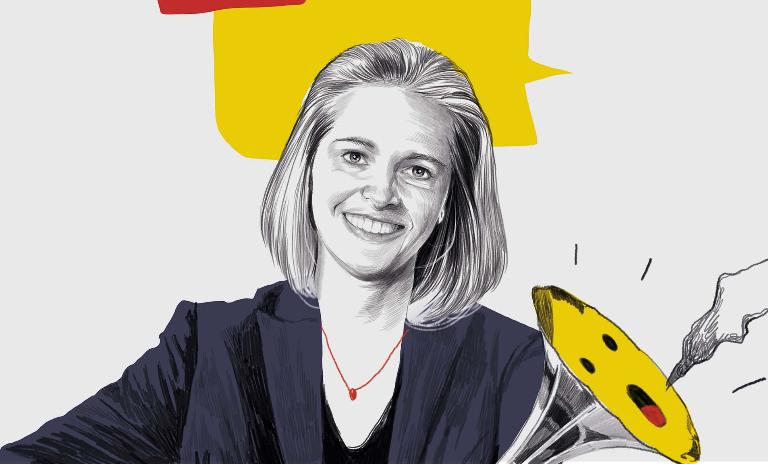Making life better
![{[downloads[language].preview]}](https://www.rolandberger.com/publications/publication_image/ta_35_001_en_cover_download_preview.jpg)
Investing in health is good for individuals and businesses. Think:Act Magazine shows how organizations can help in making life better.


by Janet Anderson
illustrations by Sören Kunz
Cultural diversity is a driver of innovation, but it can also be a cause of misunderstanding. Erin Meyer's culture map helps multicultural teams understand their differences and work together more productively.
Let’s be honest. How often have you been baffled by what you think is strange behavior from a colleague? Maybe you've just sat down to a meeting and they rush into the business before even a "hello," or stare back at you in silence as you desperately try to elicit a response. It could simply be a cultural problem. And in our globalized world, working in multicultural teams is commonplace. Diverse workforces generate new ideas and bring fresh approaches. Yet people from different cultures can fail to understand each other in surprising ways and these misunderstandings can be a barrier to doing business effectively.
Erin Meyer has trained executives from the world's top companies in cultural awareness. Her book The Culture Map offers an in-depth study of the cultural underpinnings behind people's behavior and serves as a practical guide to navigating complex cross-cultural situations. In 2016, her approach drew the attention of Reed Hastings, co-founder and CEO of Netflix , just as the company was planning to go global. Meyer helped Netflix translate its core values into other cultures. The result is a company that delivers local content to more than 200 million subscribers worldwide.
Why is it such a challenge to navigate cultural difference in the workplace?
Many of us put a lot of energy into being our best selves in our professional lives, but it's complicated when we are working internationally. What it means to be a good communicator in one culture is different than what it means to be a good communicator in another. How we build trust in one country is very different than in another. A culture mapping method gives businesspeople an opportunity to reflect on how they might adapt their style to increase their effectiveness when they're working around the world.
How do businesses use your culture mapping tool?
Netflix, for example, used it to create its own organizational culture map. They brought together their top one hundred leaders and debated in small groups where their corporate culture fell on each of the eight scales of the map. Then they compared their corporate culture map to the countries that they were moving into.
Erin Meyer is a professor at INSEAD and author of The Culture Map and No Rules Rules. The first book explores how to navigate cultural differences in the workplace. The second book, written with Reed Hastings, CEO of Netflix, looks at how Netflix's corporate culture breeds innovation around the world.
What did they discover?
Candor is an important value at Netflix. And yet the Dutch said they felt their American colleagues didn't even know how to be candid. Indeed, on the culture map, Americans are not as direct communicators as the Dutch. Dutch culture is also much more consensual when it comes to making decisions. The Netflix team realized that a lot of the issues they were having with their Dutch office had to do with the Dutch taking a long time to make decisions, while the Dutch team felt that the Americans were not being inclusive in their decision-making style. Identifying this helped them understand that these things are cultural, not personal. Then they were able to come up with strategies more effectively.
Most people aren't aware of how culture influences their own behavior. How do you help people to see this?
How we give feedback is an interesting example. Americans give more positive feedback than any other culture in the world – and often we wrap our positives around our negatives. That's very confusing to people from other countries. In France, positive feedback is given less frequently and strongly. Take another example I learned at Netflix: A French woman received a performance review from her American boss. He thought he had clearly told her that her work was unacceptable, but because he started by telling her what she was doing well, she thought it was the best feedback she'd ever received from a boss. To ensure you have correctly understood what is being said, you need to develop awareness of these cultural differences.
Do you think we need more humility?
There's nothing more disheartening than someone saying they've worked internationally for a long time, so they know all this. What was wonderful with Netflix is that when they were getting ready to move into 130 countries in 2016, they said let's try to figure out what we have to learn about the world. It started with the CEO. That level of humility and curiosity is what is needed to drive a company that operates internationally. I teach this subject every day, but I'm learning constantly.
Many people who work in international companies communicate in a language that isn't their own. How important is this in the interplay of cultural issues?
It is true that when we're speaking our native language , we have a power advantage. But who speaks up in meetings is mostly not linked to language, but to other things, like risk orientation. In the US, we're taught in school that saying something that's wrong or not thought through doesn't matter. We get a grade for participation, so the best students know they have to raise their hand as much as possible: If you don't speak up, you won't be seen as contributing. But in Singapore, Japan or Brazil, where the focus is on avoiding risk, people make sure they have thought carefully and checked with others in the group before they speak up. Once you're aware of that, you can deal with it. The leader of such a team can say, I'm going to be asking you for your input on this specific topic next week, so please prepare.
What else affects communication?
There are also differences around how [much] silence we feel comfortable with. If I'm silent for three seconds, an American will think something's wrong and respond themselves. But in Japan, people can manage 12 seconds comfortably. So that, too, means some cultures speak more. If a multicultural team isn't aware of how to facilitate discussion, then the diverse voices will not be heard, and others will take up all of the space.
You have pointed out that monocultural teams are often faster decision-makers. Is there a multicultural advantage?
When we're with people who come from the same tribe, we understand faster. Look at the executive teams of many companies: There's not much diversity. On the other hand, where the goal is to think more innovatively, multicultural teams are clearly worth the investment. It might take more time to make sure that we hear everybody's voice, and it might be an emotional journey to realize that our messages are being misunderstood, but the more that we do that, the more we open up the space of innovation that comes from diversity.
Does our globalized world mean business culture is converging on a single point?
The world's moving, but not converging. Take the dimension that looks at egalitarian vs. hierarchical cultures in my scales. This looks at how much we defer to authority. We can see that the whole world is shifting to be less hierarchical – from Nigeria, one of the most hierarchical cultures, to Denmark, the most egalitarian. But that doesn't mean that Denmark and Nigeria are coming together: It means they're moving in the same direction. We also see that the whole world is moving to more low context communication: The more we work with people from other countries, the less implicit messages work and the more we have to simplify.
How easy is it to navigate our cultural differences via videoconferences?
Computer interfaces [can] take away our ability to read each other's cues. People from more relationship-oriented cultures can't feel trust for one another if they don't build emotional bonds. It's not natural to spend time building emotional bonds via videoconference. But if you work on it, you can do it.
How did Netflix go about managing its multicultural challenge?
I think that the main thing that Netflix has learned – something I worked with them on – was to approach culture the same way they approach their television shows. Netflix has great movies and content coming out of each country with local flavor. That's exactly the way that culture should be approached. As you internationalize and move into new markets, you don't have to change your value systems, you don't have to change the underpinning reasons for why you are who you are, but you do need to let each country focus on behaviors that work in that environment. For Netflix, where candor is very important, they learned to ask, what does candor look like in each country? That's the lesson that Netflix has learned.
![{[downloads[language].preview]}](https://www.rolandberger.com/publications/publication_image/ta_35_001_en_cover_download_preview.jpg)
Investing in health is good for individuals and businesses. Think:Act Magazine shows how organizations can help in making life better.



